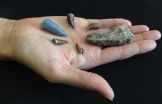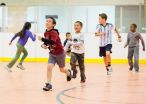(Press-News.org) Yerkes National Primate Research Center researchers are the first to show that an irradiation plus transplantation combination approach in nonhuman primates can be used to treat or even possibly cure HIV/AIDS, and this new model is providing some answers about the "Berlin patient," the only human thought cured of AIDS. The study is published in the September 25 issue of PLOS Pathogens.
Guido Silvestri, MD, division chief of Microbiology and Immunology at the Yerkes Research Center at Emory, and several of his research colleagues performed the first hematopoietic stem cell transplantation in three rhesus macaques infected with a simian human immunodeficiency virus (SHIV). Silvestri's colleagues on this study include Maud Mavigner, PhD, Yerkes and Emory Vaccine Center, Ann Chahroudi, MD, PhD, Emory University School of Medicine (EUSOM) Department of Pediatrics, and Leslie Kean, MD, PhD, and Benjamin Watkins, MD, EUSOM Department of Surgery.
The team of researchers harvested hematopoietic stem cells from three macaques prior to SHIV infection of all six animals in the study, treated the animals with anti-retroviral therapy (ART) to reduce viral load and mimic the situation in human HIV-infected patients who are treated with ART, and then exposed the three monkeys from which they had collected hematopoietic stem cells to a high dose of radiation. According to Silvestri, "This treatment eliminated most of the existing blood and immune cells, including up to 99% of the animals' CD4-T cells, which is the main target of HIV infection."
Following the irradiation, the researchers transplanted each monkey's own virus-free hematopoietic stem cells. The stem cells regenerated blood and immune cells in all three monkeys within six weeks, at which time the scientists stopped ART in all of the monkeys.
"As we expected, the virus rebounded rapidly in the control animals," says Silvestri. "Of the three transplanted animals, two also showed a rapid rebound, while the third animal had no rebound for two weeks. Unfortunately, we had to euthanize this monkey because of kidney failure, so we don't know how long this control would have lasted." Post-mortem analysis of the monkey that experienced no virus rebound after ART interruption showed low levels of viral DNA in a number of tissues.
Silvestri says, "These results support our hypothesis that a massive depletion of hematolymphoid cells by total body irradiation can cause a significant decrease in the viral reservoir in the body. At least in one monkey, we were very close to eliminating all reservoirs, so we think this approach is promising. We'll use what we've learned in this test-of-concept study to refine our research model toward our goal of curing HIV infection in all humans."
An added benefit of the researchers' work is providing insight into the cure of the Berlin patient, who was HIV-infected before irradiation for leukemia and then a bone marrow transplant. The transplant was from a donor who had a mutation that abolishes the function of the CCR5 gene, which codes for a protein that facilitates HIV entry into human cells. The mutation in homozygous carriers who, like the donor, have two defective copies protects against HIV infection. The researchers say using the CCR5 mutant donation and/or the presence of graft versus host disease, which results in the elimination of HIV-positive reservoir cells that survive irradiation, played a significant role in curing the Berlin patient.
INFORMATION:
Established in 1930, the Yerkes National Primate Research Center paved the way for what has become the National Institutes of Health-funded National Primate Research Center (NPRC) program. For more than eight decades, the Yerkes Research Center has been dedicated to conducting essential basic science and translational research to advance scientific understanding and to improve human health and well-being. Today, the Yerkes Research Center is one of only eight NPRCs. The center provides leadership, training and resources to foster scientific creativity, collaboration and discoveries, and research at the center is grounded in scientific integrity, expert knowledge, respect for colleagues, an open exchange of ideas and compassionate, quality animal care.
Within the fields of microbiology and immunology, neurologic diseases, neuropharmacology, behavioral, cognitive and developmental neuroscience, and psychiatric disorders, the center's research programs are seeking ways to: develop vaccines for infectious and noninfectious diseases; understand the basic neurobiology and genetics of social behavior and develop new treatment strategies for improving social functioning in social disorders such as autism; interpret brain activity through imaging; increase understanding of progressive illnesses such as Alzheimer's and Parkinson's diseases; unlock the secrets of memory; treat drug addiction; determine how the interaction between genetics and society shape who we are; and advance knowledge about the evolutionary links between biology and behavior.
Researchers show irradiation plus transplantation effective for treating HIV/AIDS
2014-09-29
ELSE PRESS RELEASES FROM THIS DATE:
Tooth buried in bone shows prehistoric predators tangled across land, sea
2014-09-29
About 210 million years ago when the supercontinent of Pangea was starting to break up and dog-sized dinosaurs were hiding from nearly everything, entirely different kinds of reptiles called phytosaurs and rauisuchids were at the top of the food chain.
It was widely believed the two top predators didn't interact much as the former was king of the water, and the latter ruled the land. But those ideas are changing, thanks largely to the contents of a single bone.
In a paper published online in September in the German journal Naturwissenschaften, Stephanie Drumheller of ...
Simulations reveal an unusual death for ancient stars
2014-09-29
Certain primordial stars—those 55,000 and 56,000 times the mass of our Sun, or solar masses—may have died unusually. In death, these objects—among the Universe's first-generation of stars—would have exploded as supernovae and burned completely, leaving no remnant black hole behind.
Astrophysicists at the University of California, Santa Cruz (UCSC) and the University of Minnesota came to this conclusion after running a number of supercomputer simulations at the Department of Energy's (DOE's) National Energy Research Scientific Computing Center (NERSC) and Minnesota Supercomputing ...
Myriad presents tumor BRACAnalysis CDx study at ESMO
2014-09-29
SALT LAKE CITY, Utah, Sept. 29, 2014 – Myriad Genetics, Inc. (Nasdaq: MYGN) today announced that its Tumor BRACAnalysis CDx™ companion diagnostic test significantly improved the detection of cancer-causing BRCA1/2 mutations by 44 percent in women with ovarian cancer. Data from this new study were presented at the 2014 European Society for Medical Oncology (ESMO) annual meeting in Madrid, Spain.
"Several previous clinical studies have demonstrated that patients with germline or somatic BRCA1/2 mutations respond to certain DNA-damaging medicines such as the platinum ...
Cells from placentas safe for patients with multiple sclerosis
2014-09-29
Patients with Multiple Sclerosis (MS) were able to safely tolerate treatment with cells cultured from human placental tissue, according to a study published today in the journal Multiple Sclerosis and Related Disorders. The study, which is the first of its kind, was conducted by researchers at Mount Sinai, Celgene Cellular Therapeutics subsidiary of Celgene Corporation and collaborators at several other institutions.
While designed to determine safety of the treatment, early signals in the data also suggested that a preparation of cultured cells called PDA-001 may repair ...
Greenland Ice Sheet more vulnerable to climate change than previously thought
2014-09-29
A new model developed by researchers at the University of Cambridge has shown that despite its apparent stability, the massive ice sheet covering most of Greenland is more sensitive to climate change than earlier estimates have suggested, which would accelerate the rising sea levels that threaten coastal communities worldwide.
In addition to assessing the impact of the increasing levels of meltwater created and spilled into the ocean each year as the climate continues to warm, the new model also takes into account the role that the soft, spongy ground beneath the ice ...
Scientists discover a new role for estrogen in the pathology of breast cancer
2014-09-29
CHAMPAIGN, Ill. — Scientists have discovered a previously unknown mechanism by which estrogen prepares cells to divide, grow and, in the case of estrogen-positive breast cancers, resist cancer drugs. The researchers say the work reveals new targets for breast cancer therapy and will help doctors predict which patients need the most aggressive treatment.
The University of Illinois team reports its findings in the journal Oncogene.
Estrogen pre-activates the unfolded-protein response (UPR), a pathway that normally protects cells from stress, the researchers report. The ...
Climate change appears a mixed bag for a common frog
2014-09-29
Scientists have found amphibians worldwide are breeding earlier due to climate change, but how that affects species is just now being answered.
After warmer winters, wood frogs breed earlier and produce fewer eggs, a Case Western Reserve University researcher has found.
Michael F. Benard, the George B. Mayer Chair in Urban and Environmental Studies and assistant professor of biology, also found that frogs produce more eggs during winters with more rain and snow.
Benard's study, published today in the journal Global Change Biology, is among the first in a natural habitat ...
After-school exercise program enhances cognition in 7-, 8- and 9-year-olds
2014-09-29
CHAMPAIGN, Ill. — A nine-month-long, randomized controlled trial involving 221 prepubescent children found that those who engaged in moderate-to-vigorous physical activity for at least 60 minutes a day after school saw substantial improvements in their ability to pay attention, avoid distraction and switch between cognitive tasks, researchers report in the journal Pediatrics.
Half of the study subjects were randomly assigned to the after-school program and the rest were placed on a wait list. All participants underwent cognitive testing and brain imaging before and after ...
Hand size appears to stay constant, providing natural 'ruler'
2014-09-29
People tend to perceive their dominant hand as staying relatively the same size even when it's magnified, lending support to the idea that we use our hand as a constant perceptual "ruler" to measure the world around us. The findings are published in Psychological Science, a journal of the Association for Psychological Science.
"These findings suggest that our bodies are used as perceptual metrics, meaning that we are more likely to attribute changes in the perceived size of the hand to changes in the world — instead of thinking that our hand has become bigger, we're more ...
More children admitted to intensive care but with lower staffing ratios
2014-09-29
More children than ever are being admitted to intensive care units in England and Wales but there are fewer staff per bed available to cope with the increase, according to a new report published jointly by the University of Leeds and University of Leicester.
The Paediatric Intensive Care Audit Network (PICANet) report showed that there was a 15% increase in admissions over a 10-year period between 2004 and 2013, but this included an increase of 4% that was not due to changes in the childhood population.
At the same time, staffing levels have increased by 36% but this ...





